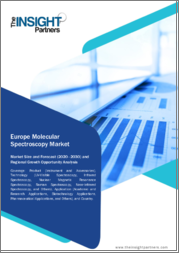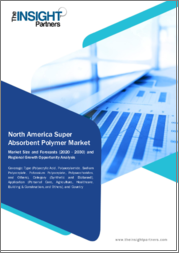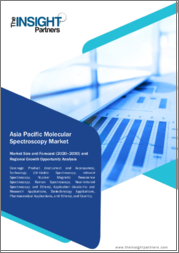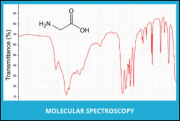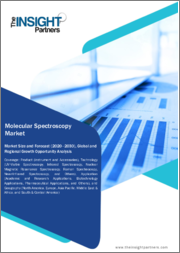
|
시장보고서
상품코드
1450829
세계의 분자 분광법 시장 : 시장 규모와 예측, 세계 및 지역 점유율, 동향, 성장 기회 분석 : 제품, 기술, 용도, 지역별Molecular Spectroscopy Market Size and Forecasts, Global and Regional Share, Trend, and Growth Opportunity Analysis By Product, Technology, Application, and Geography |
||||||
분자분광법 시장 규모는 2022년 38억 달러에서 2030년 55억 8,000만 달러로 급증할 것으로 예측되고 있으며, 복합 연간 성장률(CAGR) 4.9%를 나타낼 것으로 예측됩니다. 분자분광법의 채용과 이용 확대, 제약업계의 급성장이 분자분광법 시장의 성장을 뒷받침하고 있습니다.
분자 분광법은 의약품 및 기타 생명공학 제품의 연구 개발(R&D)에 사용되며, 이는 분자 분광법 시장의 성장으로 이어집니다. 근적외(NIR) 분광법은 분자 분광법의 일종이며, 다른 분석 기술에 비해 큰 이점이 있기 때문에 최근 제약 업계에서 널리 인지되게 되었습니다. 샘플 준비의 번거로움을 없애고 단일 스펙트럼으로부터 화학적 및 물리적 샘플 파라미터를 얻을 수 있는 능력을 발휘합니다. 라만 분광법은 또한 의약품 및 의약품 개발에서 수행되는 강력한 분석 기술 중 하나입니다. 라만 분광법은 구조 활성 상관 연구, 반응 조건 개선, 다형성 및 제형 스크리닝과 같은 화합물을 창약에서 개발로 전환시키는 데 필요한 규모로 이어지는 다른 매개 변수에 사용됩니다. 게다가 핵자기공명(NMR) 분광법은 견고한 도구로 여겨지며, 새로운 치료제 개발에 이 기술의 사용이 증가하고 있으며 분자분광법 시장 예측에 중요한 역할을 하고 있습니다.
분자 분광법의 채용과 이용 증가가 분자 분광법 시장을 견인
분자 분광법은 의약품 및 기타 생명 공학 제품의 연구 개발(R&D)에 사용됩니다. 근적외(NIR) 분광법은 분자 분광법의 일종이며, 다른 분석 기술에 비해 큰 이점이 있기 때문에 최근 제약 업계에서 널리 인지되게 되었습니다. 샘플 준비의 번거로움을 없애고 단일 스펙트럼에서 화학적 및 물리적 샘플 파라미터를 얻을 수 있는 능력을 발휘합니다. 라만 분광법은 또한 신약 및 의약품 개발에서 수행되는 강력한 분석 기술 중 하나입니다. 라만 분광법은 구조 활성 상관 연구, 반응 조건 개선, 다형성 및 제형 스크리닝과 같은 화합물을 창약에서 개발로 전환시키는 데 필요한 규모로 이어지는 다른 매개 변수에 사용됩니다. 게다가, 핵자기 공명(NMR) 분광법은 견고한 도구로 여겨지며, 새로운 치료제의 개발에 이 기술이 사용되고 있습니다. 2021년 3월 Bruker Corp.는 업계 표준 자동화 옵션을 갖춘 다핵 그라디언트 분광법에 사용되는 차세대 80MHz 고성능 푸리에 변환 NMR 벤치탑 분광기인 영구 자석 푸리에 80 시스템 출시 발표 했습니다.
시장 기회
핵 자기 공명 분광법의 이용 증가
NMR은 시료의 순도와 분자 구조를 결정하는 품질 관리 및 연구에 사용되는 분석 기술입니다. NMR은 분석 화학 및 연결 물질 과학의 관점에서 고분자의 구조와 역학을 해명하는 강력한 도구입니다. NMR 분광법의 장점은 샘플 준비가 적고 연구 대상 분자를 보존하는 비파괴적인 방법이라는 것입니다. NMR 분광법은 유기 화합물의 구조를 알기 위한 주요 기술 중 하나로, 의약품, 생명공학, 바이오의약품 등 다양한 분야에서 널리 이용되고 있습니다. 게다가 NMR 분광법은 히트 투 리드 검출, 대사물 프로파일링, in vivo 자기 공명 분광법, 자기 공명 이미징 등 생화학적 및 생물학적 응용에 대한 이용도 진행하고 있습니다.
최근 NMR은 대사체학에 크게 통합되어 있습니다. 이 급성장 분야는 대사 산물을 연구하여 질병에 대한 정보를 얻는 것입니다. 대사체학은 종래에는 연구 용도가 중심이었지만, 실험실에서의 진단에 매우 유용한 것이 증명되었습니다. 대사 및 세포 과정의 하류 산물에 대한 귀중한 정보를 제공하여 특정 조직 및 기관의 상태에 대한 인사이트을 얻을 수 있습니다. NMR 분광법은 소변, 혈장, 혈청 등 다양한 체액 중 대사물 농도의 정량화에 성공하고 있습니다. NMR 스펙트로스카피는 새로운 발전을 이루고, 필요했던 감도와 범용성의 향상을 촉진하고, 응용의 폭을 넓히고 있습니다. 첨단 NMR 진단 기술을 헬스케어 산업의 최전선에 도입함으로써 다양한 질환의 신속하고 비용 효율적인 진단이 가능해질 것으로 예상됩니다. 연구와 산업계의 요구가 계속 발전하고 있는 가운데, NMR 분광법은 분석기술의 최전선에 계속해서 분광법 시장의 성장을 견인하고 있습니다.
게다가 분자분광법은 환경보전에 있어서의 연구 증가와 환경연구를 촉진하는 정부의 유리한 정책에 의해 크게 추진되고 있습니다. 분자 분광법은 종종 조사 및 환경 조사에서 분석 도구로 사용됩니다. 따라서 시장 진출 기업은 다양한 환경 조사를 위해 혁신적인 분자 분광법을 모색하고 있습니다. 이는 예측 기간 동안 계속되고 시장에 성장 기회를 가져올 것으로 예상됩니다.
분자 분광법 시장은 제품, 기술, 용도, 지역에 따라 구분됩니다.
제품 유형 기반 인사이트
제품 유형에 따라 분자 분광 시장은 장비와 액세서리로 구분됩니다. 2022년 시장 점유율은 장비 부문이 큽니다. 또한 이 부문은 예측 기간 동안 5.1%의 높은 복합 연간 성장률(CAGR)을 나타낼 것으로 예측됩니다.
분광계는 작동 원리에 따라 분산형, 필터 기반, 푸리에 변환형의 세 가지 주요 유형으로 나뉩니다. 푸리에 변환 분광기(FTS 또는 FT 분광기)는 지난 수십년동안 많은 적외선 및 근적외선 응용 분야에서 분산형 분광기를 대체했습니다. 간섭계는 모든 푸리에 변환 분광기의 심장 부분입니다. 현재 세대의 FT 분광기는 다양한 간섭계 설계를 채택하고 있습니다.
용도 기반 인사이트
분자 분광 시장은 용도에 따라 학술 및 연구 용도, 생명 공학 용도, 제약 용도 등으로 구분됩니다. 학술 및 연구 용도 부문은 2022년에 큰 시장 점유율을 차지하며, 이 부문은 예측 기간 동안 5.4%라는 높은 복합 연간 성장률(CAGR)을 나타낼 것으로 예측됩니다.
학술기관 및 연구기관은 분자분광법 시장의 매우 중요한 공헌자이며, 특히 생명공학, 세포 배양, 재생의료에 종사하는 기관입니다. 이들 기관은 다양한 제품의 생체적합성과 확장성을 면밀히 평가하는 중요한 시험,검증 센터로서의 역할을 하고 있습니다. 연구개발기관은 분자분광법 시장에서의 혁신, 신제품 및 신기술의 도입, 서비스 제공을 위한 프로세스 및 활동에 종사하고 있습니다. R&D는 제품 도입을 가속화하는 데에도 중요합니다. 연구개발기관의 성장은 연구와 혁신 과정에 대한 생물반응기의 채용이 증가하고 있는 것이 주요 요인입니다. 게다가 연구기관은 바이오프로세스를 강화하기 위해 다액의 투자를 하고 있으며, 이것이 시장의 성장에 연결되고 있습니다.
미국 식품의약품국, 질병관리예방센터, 경제산업성, 일본무역진흥기구, 사우디아라비아 투자성, 국민보건서비스, 유럽의약품청 등은 분자분광법 시장 조사보고서를 작성할 때 참조한 관련 정보원의 일부입니다.
목차
제1장 서론
제2장 주요 요약
- 주요 인사이트
- 분자분광법 시장 : 지역별
제3장 조사 방법
- 조사 범위
- 2차 조사
- 1차 조사
제4장 분자 분광법 시장 상황
- 개관
- 세계 PEST 분석
제5장 분자 분광법 시장-주요 시장 역학
- 분자 분광법 시장 - 주요 시장 역학
- 시장 성장 촉진요인
- 분자 분광법의 보급과 이용의 확대
- 제약업계의 급성장
- 시장 성장 억제요인
- 숙련 기술자의 부족과 메인터넌스와 설치의 고비용
- 시장 기회
- 핵자기 공명 분광법의 이용 증가
- 향후의 동향
- 창약과 연구개발 증가
- 성장 촉진요인과 억제요인의 영향
제6장 분자 분광법 시장 : 시장 분석
- 분자 분광법 시장 수익(2022년-2030년)
- 분자분광법 시장-지역별 분석(2022년-2030년)
제7장 분자 분광법 시장 분석 - 제품별
- 장치
- 부속품
제8장 분자 분광법 시장 분석 - 기술별
- 자외선 가시광선 분광법
- 적외 분광법
- 핵자기 공명 분광법
- 라만 분광법
- 근적외 분광법
- 기타
제9장 분자 분광법 시장 분석 - 용도별
- 학술,연구 용도
- 바이오테크놀러지 용도
- 제약용도
- 기타
제10장 분자분광법 시장 : 지역별 분석
- 북미
- 미국
- 캐나다
- 멕시코
- 유럽
- 영국
- 독일
- 프랑스
- 이탈리아
- 스페인
- 기타 유럽
- 아시아태평양
- 중국
- 일본
- 인도
- 호주
- 한국
- APAC 기타 국가
- 중동 및 아프리카
- 사우디아라비아
- 남아프리카
- 아랍에미리트(UAE)
- 기타 중동 및 아프리카
- 중남미
- 브라질
- 아르헨티나
- 기타 중남미
제11장 분자분광법 시장-업계 정세
- 분자 분광법 시장에서의 성장 전략
- 무기적 성장 전략
- 유기적 성장 전략
제12장 기업 프로파일
- Horiba Ltd
- Thermo Fisher Scientific Inc
- Silios Technologies SA
- Merck KGaA
- Revvity Inc
- Ostec Instruments
- JEOL Ltd
- Shimadzu Corp
- JASCO Corp
- Bruker Corp
- Agilent Technologies Inc
- Oxford Instruments Plc
- Teledyne Princeton Instruments Inc
제13장 부록
BJH 24.04.25The molecular spectroscopy market size is projected to surge from US$ 3.80 billion in 2022 to US$ 5.58 billion by 2030; the market is estimated to record a CAGR of 4.9% during 2022-2030. The growing adoption and use of molecular spectroscopy and the rapid growth of the pharmaceutical industry propel the molecular spectroscopy market growth.
Molecular spectroscopy is used in the research and development (R&D) of pharmaceuticals and other biotechnological products, which leads to the molecular spectroscopy market growth. Near-infrared (NIR) spectroscopy is one of the types of molecular spectroscopy that has gained wide recognition in the pharmaceutical industry in recent years due to its huge advantages over other analysis techniques; it helps in effortless sample preparation and exhibits the ability to obtain chemical and physical sample parameters from a single spectrum. Raman spectroscopy is also one of the powerful analytical techniques implemented in drug discovery and pharmaceutical development. It is used to study structural activity relationships and improve reaction conditions and other parameters, such as polymorph and formulation screening, that lead to the scale required to move drug compounds from discovery to development. Further, nuclear magnetic resonance (NMR) spectroscopy is considered a robust tool, and the use of this technique for developing novel therapeutics has increased, which plays an important role in the molecular spectroscopy market forecast.
Growing Adoption and Use of Molecular Spectroscopy Drives the Molecular Spectroscopy Market
Molecular spectroscopy is used in the research and development (R&D) of pharmaceuticals and other biotechnological products. Near-infrared (NIR) spectroscopy is one of the types of molecular spectroscopy that has gained wide recognition in the pharmaceutical industry in recent years due to its huge advantages over other analysis techniques; it helps in effortless sample preparation and exhibits the ability to obtain chemical and physical sample parameters from a single spectrum. Raman spectroscopy is also one of the powerful analytical techniques implemented in drug discovery and pharmaceutical development. It is used to study structural activity relationships and improve reaction conditions and other parameters, such as polymorph and formulation screening, that lead to the scale required to move drug compounds from discovery to development. Further, nuclear magnetic resonance (NMR) spectroscopy is considered a robust tool, and the use of this technique for developing novel therapeutics has increased. In March 2021, Bruker Corp. announced the launch of a permanent magnet Fourier 80 system, a next-generation, 80 MHz high-performance Fourier transform NMR benchtop spectrometer used for multinuclear gradient spectroscopy with industry-standard automation options.
Market Opportunity
Increasing Use of Nuclear Magnetic Resonance Spectroscopy
NMR is an analytical technique used for quality control and research to determine the purity of a sample with its molecular structure. NMR is a powerful tool in terms of analytical chemistry and consolidated matter science, as well as for elucidating the structure and dynamics of macromolecules. The benefits of NMR spectroscopy are that it requires less sample preparation and is a non-destructive method that preserves the molecules being studied. NMR spectroscopy has become one of the leading techniques for finding out the structure of organic compounds and is widely used in various areas such as pharmaceuticals, biotechnology, and biopharmaceuticals. In addition, NMR spectroscopy is increasingly used in biochemical and biological applications, including hit-to-lead detection, metabolite profiling, in vivo magnetic resonance spectroscopy, and magnetic resonance imaging.
In recent years, NMR has been heavily incorporated into metabolomics. This rapidly growing field involves the study of metabolites to gain information about diseases. Metabolomics has traditionally focused on research applications and can prove extremely useful in laboratory diagnostics. Metabolomics can provide valuable information about downstream products of metabolic and cellular processes and provide insights into the state of specific tissues and organs. NMR spectroscopy has successfully quantified metabolite concentrations in various fluids, including urine, plasma, and serum. New developments have been made in NMR spectroscopy, driving much-needed improvements in sensitivity and versatility, and expanding the number of applications. Introducing advanced NMR diagnostic techniques to the frontline healthcare industry will likely enable rapid and cost-effective diagnosis of various diseases. As research and industry needs continue to evolve, NMR spectroscopy remains at the forefront of analytical techniques and drives growth in the spectroscopy market.
In addition, molecular spectroscopy has propelled significantly due to increasing research in conservation and favorable government policies to promote environmental studies. Molecular spectroscopy is often used as an analytical tool in surveys and environmental studies. Therefore, market participants are exploring innovative molecular spectroscopy methods for various environmental studies. This is expected to continue during the forecast period and provide growth opportunities for the market.
The "Global Molecular Spectroscopy Market" is segmented on the basis of product, technology, application, and geography.
Product Type-Based Insights
Based on product type, the molecular spectroscopy market is segmented into instruments and accessories. The instrument segment held a larger market share in 2022. Moreover, the same segment is anticipated to register a higher CAGR of 5.1% during the forecast period.
Spectrometers can be divided into three main types based on operating principles: dispersive, filter-based, and Fourier transform instruments. Fourier transform spectrometers (FTS or FT spectrometers) have replaced dispersive instruments in many infrared and near-infrared applications over the past few decades. The interferometer is the heart of every Fourier transform spectrometer. The current generation FT spectrometers use various interferometer designs.
Application-Based Insights
Based on application, the molecular spectroscopy market is segmented into academic and research applications, biotechnology applications, pharmaceutical applications, and others. The academic and research applications segment held a larger market share in 2022, and the same segment is anticipated to register a higher CAGR of 5.4% during the forecast period.
Academic and research institutes are pivotal contributors to the molecular spectroscopy market, especially those working in biotechnology, cell culture, and regenerative medicine. These institutions serve as critical testing and validation centers, meticulously assessing the biocompatibility and scalability of various products. Research and development organizations are engaged in the processes and activities to innovate, introduce new products and technologies, and provide services in the molecular spectroscopy market. Research and development is also important to accelerate product introductions. The growth of research and development organizations is majorly attributed to the increasing adoption of bioreactors for research and innovation processes. Additionally, the research institutes invest heavily to boost the bioprocesses, leading to market growth.
US Food and Drug Administration, Centers for Disease Control and Prevention, Ministry Of Economy, Trade, And Industry, Japan External Trade Organization, Saudi Arabia's Ministry of Investment, National Health Services, and European Medicines Agency are some of the relevant sources referred while preparing the molecular spectroscopy market research report.
Table Of Contents
1. Introduction
- 1.1 The Insight Partners Research Report Guidance
- 1.2 Market Segmentation
2. Executive Summary
- 2.1 Key Insights
- 2.2 Molecular Spectroscopy Market, by Geography (US$ Million)
3. Research Methodology
- 3.1 Coverage
- 3.2 Secondary Research
- 3.3 Primary Research
4. Molecular Spectroscopy Market Landscape
- 4.1 Overview
- 4.2 Global PEST Analysis
5. Molecular Spectroscopy Market - Key Market Dynamics
- 5.1 Molecular Spectroscopy Market - Key Market Dynamics
- 5.2 Market Drivers
- 5.2.1 Growing Adoption and Use of Molecular Spectroscopy
- 5.2.2 Rapid Growth of Pharmaceutical Industry
- 5.3 Market Restraints
- 5.3.1 Shortage of Technically Skilled Personnel and High Cost of Maintenance and Installation
- 5.4 Market Opportunities
- 5.4.1 Increasing Use of Nuclear Magnetic Resonance Spectroscopy
- 5.5 Future Trends
- 5.5.1 Increase in Drug Discovery and R&D
- 5.6 Impact of Drivers and Restraints:
6. Molecular Spectroscopy Market - Global Market Analysis
- 6.1 Molecular Spectroscopy Market Revenue (US$ Million), 2022-2030
- 6.2 Molecular Spectroscopy Market- Breakdown by Geography, 2022-2030
7. Molecular Spectroscopy Market Analysis - by Product
- 7.1 Overview
- 7.2 Instrument
- 7.2.1 Overview
- 7.2.2 Instrument: Molecular Spectroscopy Market - Revenue and Forecast to 2030 (US$ Million)
- 7.3 Accessories
- 7.3.1 Overview
- 7.3.2 Accessories: Molecular Spectroscopy Market - Revenue and Forecast to 2030 (US$ Million)
8. Molecular Spectroscopy Market Analysis - by Technology
- 8.1 Overview
- 8.2 UV-Visible Spectroscopy
- 8.2.1 Overview
- 8.2.2 UV-Visible Spectroscopy: Molecular Spectroscopy Market - Revenue and Forecast to 2030 (US$ Million)
- 8.3 Infrared Spectroscopy
- 8.3.1 Overview
- 8.3.2 Infrared Spectroscopy: Molecular Spectroscopy Market - Revenue and Forecast to 2030 (US$ Million)
- 8.4 Nuclear Magnetic Resonance Spectroscopy
- 8.4.1 Overview
- 8.4.2 Nuclear Magnetic Resonance Spectroscopy: Molecular Spectroscopy Market - Revenue and Forecast to 2030 (US$ Million)
- 8.5 Raman Spectroscopy
- 8.5.1 Overview
- 8.5.2 Raman Spectroscopy: Molecular Spectroscopy Market - Revenue and Forecast to 2030 (US$ Million)
- 8.6 Near-Infrared Spectroscopy
- 8.6.1 Overview
- 8.6.2 Near-Infrared Spectroscopy: Molecular Spectroscopy Market - Revenue and Forecast to 2030 (US$ Million)
- 8.7 Others
- 8.7.1 Overview
- 8.7.2 Others: Molecular Spectroscopy Market - Revenue and Forecast to 2030 (US$ Million)
9. Molecular Spectroscopy Market Analysis - by Application
- 9.1 Overview
- 9.2 Academic and Research Applications
- 9.2.1 Overview
- 9.2.2 Academic and Research Applications: Molecular Spectroscopy Market - Revenue and Forecast to 2030 (US$ Million)
- 9.3 Biotechnology Applications
- 9.3.1 Overview
- 9.3.2 Biotechnology Applications: Molecular Spectroscopy Market - Revenue and Forecast to 2030 (US$ Million)
- 9.4 Pharmaceutical Applications
- 9.4.1 Overview
- 9.4.2 Pharmaceutical Applications: Molecular Spectroscopy Market - Revenue and Forecast to 2030 (US$ Million)
- 9.5 Others
- 9.5.1 Overview
- 9.5.2 Others: Molecular Spectroscopy Market - Revenue and Forecast to 2030 (US$ Million)
10. Molecular Spectroscopy Market - Geographical Analysis
- 10.1 North America Molecular Spectroscopy Market, Revenue and Forecast To 2030
- 10.1.1 Overview
- 10.1.2 North America: Molecular Spectroscopy Market - Revenue and Forecast to 2030 (US$ Million)
- 10.1.2.1 North America: Molecular Spectroscopy Market - Revenue and Forecast Analysis - by Product
- 10.1.2.2 North America: Molecular Spectroscopy Market - Revenue and Forecast Analysis - by Technology
- 10.1.2.3 North America: Molecular Spectroscopy Market - Revenue and Forecast Analysis - by Application
- 10.1.2.4 North America: Molecular Spectroscopy Market - Revenue and Forecast Analysis - by Country
- 10.1.2.5 US
- 10.1.2.5.1 Overview
- 10.1.2.5.2 US: Molecular Spectroscopy Market - Revenue and Forecast to 2030 (US$ Million)
- 10.1.2.5.3 US: Molecular Spectroscopy Market Breakdown, by Product
- 10.1.2.5.4 US: Molecular Spectroscopy Market Breakdown, by Technology
- 10.1.2.5.5 US: Molecular Spectroscopy Market Breakdown, by Application
- 10.1.2.6 Canada
- 10.1.2.6.1 Overview
- 10.1.2.6.2 Canada: Molecular Spectroscopy Market - Revenue and Forecast to 2030 (US$ Million)
- 10.1.2.6.3 Canada: Molecular Spectroscopy Market Breakdown, by Product
- 10.1.2.6.4 Canada: Molecular Spectroscopy Market Breakdown, by Technology
- 10.1.2.6.5 Canada: Molecular Spectroscopy Market Breakdown, by Application
- 10.1.2.7 Mexico
- 10.1.2.7.1 Overview
- 10.1.2.7.2 Mexico: Molecular Spectroscopy Market - Revenue and Forecast to 2030 (US$ Million)
- 10.1.2.7.3 Mexico: Molecular Spectroscopy Market Breakdown, by Product
- 10.1.2.7.4 Mexico: Molecular Spectroscopy Market Breakdown, by Technology
- 10.1.2.7.5 Mexico: Molecular Spectroscopy Market Breakdown, by Application
- 10.2 Europe Molecular Spectroscopy Market, Revenue and Forecast To 2030
- 10.2.1 Overview
- 10.2.2 Europe: Molecular Spectroscopy Market - Revenue and Forecast to 2030 (US$ Million)
- 10.2.2.1 Europe: Molecular Spectroscopy Market - Revenue and Forecast Analysis - by Product
- 10.2.2.2 Europe: Molecular Spectroscopy Market - Revenue and Forecast Analysis - by Technology
- 10.2.2.3 Europe: Molecular Spectroscopy Market Breakdown, by Application
- 10.2.2.4 Europe: Molecular Spectroscopy Market - Revenue and Forecast Analysis - by Application
- 10.2.2.5 Europe: Molecular Spectroscopy Market - Revenue and Forecast Analysis - by Country
- 10.2.2.6 UK
- 10.2.2.6.1 Overview
- 10.2.2.6.2 UK: Molecular Spectroscopy Market - Revenue and Forecast to 2030 (US$ Million)
- 10.2.2.6.3 UK: Molecular Spectroscopy Market Breakdown, by Product
- 10.2.2.6.4 UK: Molecular Spectroscopy Market Breakdown, by Technology
- 10.2.2.6.5 UK: Molecular Spectroscopy Market Breakdown, by Application
- 10.2.2.7 Germany
- 10.2.2.7.1 Overview
- 10.2.2.7.2 Germany: Molecular Spectroscopy Market - Revenue and Forecast to 2030 (US$ Million)
- 10.2.2.7.3 Germany: Molecular Spectroscopy Market Breakdown, by Product
- 10.2.2.7.4 Germany: Molecular Spectroscopy Market Breakdown, by Technology
- 10.2.2.7.5 Germany: Molecular Spectroscopy Market Breakdown, by Application
- 10.2.2.8 France
- 10.2.2.8.1 Overview
- 10.2.2.8.2 France: Molecular Spectroscopy Market - Revenue and Forecast to 2030 (US$ Million)
- 10.2.2.8.3 France: Molecular Spectroscopy Market Breakdown, by Product
- 10.2.2.8.4 France: Molecular Spectroscopy Market Breakdown, by Technology
- 10.2.2.8.5 France: Molecular Spectroscopy Market Breakdown, by Application
- 10.2.2.9 Italy
- 10.2.2.9.1 Overview
- 10.2.2.9.2 Italy: Molecular Spectroscopy Market - Revenue and Forecast to 2030 (US$ Million)
- 10.2.2.9.3 Italy: Molecular Spectroscopy Market Breakdown, by Product
- 10.2.2.9.4 Italy: Molecular Spectroscopy Market Breakdown, by Technology
- 10.2.2.9.5 Italy: Molecular Spectroscopy Market Breakdown, by Application
- 10.2.2.10 Spain
- 10.2.2.10.1 Overview
- 10.2.2.10.2 Spain: Molecular Spectroscopy Market - Revenue and Forecast to 2030 (US$ Million)
- 10.2.2.10.3 Spain: Molecular Spectroscopy Market Breakdown, by Product
- 10.2.2.10.4 Spain: Molecular Spectroscopy Market Breakdown, by Technology
- 10.2.2.10.5 Spain: Molecular Spectroscopy Market Breakdown, by Application
- 10.2.2.11 Rest of Europe
- 10.2.2.11.1 Overview
- 10.2.2.11.2 Rest of Europe: Molecular Spectroscopy Market - Revenue and Forecast to 2030 (US$ Million)
- 10.2.2.11.3 Rest of Europe: Molecular Spectroscopy Market Breakdown, by Product
- 10.2.2.11.4 Rest of Europe: Molecular Spectroscopy Market Breakdown, by Technology
- 10.2.2.11.5 Rest of Europe: Molecular Spectroscopy Market Breakdown, by Application
- 10.3 Asia Pacific Molecular Spectroscopy Market, Revenue and Forecast To 2030
- 10.3.1.1 Overview
- 10.3.1.2 Asia Pacific: Molecular Spectroscopy Market - Revenue and Forecast to 2030 (US$ Million)
- 10.3.1.3 Asia Pacific: Molecular Spectroscopy Market - Revenue and Forecast Analysis - by Product
- 10.3.1.4 Asia Pacific: Molecular Spectroscopy Market - Revenue and Forecast Analysis - by Technology
- 10.3.1.5 Asia Pacific: Molecular Spectroscopy Market - Revenue and Forecast Analysis - by Application
- 10.3.1.6 Asia Pacific: Molecular Spectroscopy Market - Revenue and Forecast Analysis - by Country
- 10.3.1.7 China
- 10.3.1.7.1 Overview
- 10.3.1.7.2 China: Molecular Spectroscopy Market - Revenue and Forecast to 2030 (US$ Million)
- 10.3.1.7.3 China: Molecular Spectroscopy Market Breakdown, by Product
- 10.3.1.7.4 China: Molecular Spectroscopy Market Breakdown, by Technology
- 10.3.1.7.5 China: Molecular Spectroscopy Market Breakdown, by Application
- 10.3.1.8 Japan
- 10.3.1.8.1 Overview
- 10.3.1.8.2 Japan: Molecular Spectroscopy Market - Revenue and Forecast to 2030 (US$ Million)
- 10.3.1.8.3 Japan: Molecular Spectroscopy Market Breakdown, by Product
- 10.3.1.8.4 Japan: Molecular Spectroscopy Market Breakdown, by Technology
- 10.3.1.8.5 Japan: Molecular Spectroscopy Market Breakdown, by Application
- 10.3.1.9 India
- 10.3.1.9.1 Overview
- 10.3.1.9.2 India: Molecular Spectroscopy Market - Revenue and Forecast to 2030 (US$ Million)
- 10.3.1.9.3 India: Molecular Spectroscopy Market Breakdown, by Product
- 10.3.1.9.4 India: Molecular Spectroscopy Market Breakdown, by Technology
- 10.3.1.9.5 India: Molecular Spectroscopy Market Breakdown, by Application
- 10.3.1.10 Australia
- 10.3.1.10.1 Overview
- 10.3.1.10.2 Australia: Molecular Spectroscopy Market - Revenue and Forecast to 2030 (US$ Million)
- 10.3.1.10.3 Australia: Molecular Spectroscopy Market Breakdown, by Product
- 10.3.1.10.4 Australia: Molecular Spectroscopy Market Breakdown, by Technology
- 10.3.1.10.5 Australia: Molecular Spectroscopy Market Breakdown, by Application
- 10.3.1.11 South Korea
- 10.3.1.11.1 Overview
- 10.3.1.11.2 South Korea: Molecular Spectroscopy Market - Revenue and Forecast to 2030 (US$ Million)
- 10.3.1.11.3 South Korea: Molecular Spectroscopy Market Breakdown, by Product
- 10.3.1.11.4 South Korea: Molecular Spectroscopy Market Breakdown, by Technology
- 10.3.1.11.5 South Korea: Molecular Spectroscopy Market Breakdown, by Application
- 10.3.1.12 Rest of APAC
- 10.3.1.12.1 Overview
- 10.3.1.12.2 Rest of APAC: Molecular Spectroscopy Market - Revenue and Forecast to 2030 (US$ Million)
- 10.3.1.12.3 Rest of APAC: Molecular Spectroscopy Market Breakdown, by Product
- 10.3.1.12.4 Rest of APAC: Molecular Spectroscopy Market Breakdown, by Technology
- 10.3.1.12.5 Rest of APAC: Molecular Spectroscopy Market Breakdown, by Application
- 10.4 Middle East & Africa Molecular Spectroscopy Market, Revenue and Forecast To 2030
- 10.4.1 Overview
- 10.4.2 Middle East & Africa: Molecular Spectroscopy Market - Revenue and Forecast to 2030 (US$ Million)
- 10.4.2.1 Middle East & Africa: Molecular Spectroscopy Market - Revenue and Forecast Analysis - by Product
- 10.4.2.2 Middle East & Africa: Molecular Spectroscopy Market - Revenue and Forecast Analysis - by Technology
- 10.4.2.3 Middle East & Africa: Molecular Spectroscopy Market - Revenue and Forecast Analysis - by Application
- 10.4.2.4 Middle East & Africa: Molecular Spectroscopy Market - Revenue and Forecast Analysis - by Country
- 10.4.2.5 Saudi Arabia
- 10.4.2.5.1 Overview
- 10.4.2.5.2 Saudi Arabia: Molecular Spectroscopy Market - Revenue and Forecast to 2030 (US$ Million)
- 10.4.2.5.3 Saudi Arabia: Molecular Spectroscopy Market Breakdown, by Product
- 10.4.2.5.4 Saudi Arabia: Molecular Spectroscopy Market Breakdown, by Technology
- 10.4.2.5.5 Saudi Arabia: Molecular Spectroscopy Market Breakdown, by Application
- 10.4.2.6 South Africa
- 10.4.2.6.1 Overview
- 10.4.2.6.2 South Africa: Molecular Spectroscopy Market - Revenue and Forecast to 2030 (US$ Million)
- 10.4.2.6.3 South Africa: Molecular Spectroscopy Market Breakdown, by Product
- 10.4.2.6.4 South Africa: Molecular Spectroscopy Market Breakdown, by Technology
- 10.4.2.6.5 South Africa: Molecular Spectroscopy Market Breakdown, by Application
- 10.4.2.7 UAE
- 10.4.2.7.1 Overview
- 10.4.2.7.2 UAE: Molecular Spectroscopy Market - Revenue and Forecast to 2030 (US$ Million)
- 10.4.2.7.3 UAE: Molecular Spectroscopy Market Breakdown, by Product
- 10.4.2.7.4 UAE: Molecular Spectroscopy Market Breakdown, by Technology
- 10.4.2.7.5 UAE: Molecular Spectroscopy Market Breakdown, by Application
- 10.4.2.8 Rest of Middle East & Africa
- 10.4.2.8.1 Overview
- 10.4.2.8.2 Rest of Middle East & Africa: Molecular Spectroscopy Market - Revenue and Forecast to 2030 (US$ Million)
- 10.4.2.8.3 Rest of Middle East & Africa: Molecular Spectroscopy Market Breakdown, by Product
- 10.4.2.8.4 Rest of Middle East & Africa: Molecular Spectroscopy Market Breakdown, by Technology
- 10.4.2.8.5 Rest of Middle East & Africa: Molecular Spectroscopy Market Breakdown, by Application
- 10.5 South & Central America Molecular Spectroscopy Market, Revenue and Forecast To 2030
- 10.5.1 Overview
- 10.5.2 South & Central America: Molecular Spectroscopy Market - Revenue and Forecast to 2030 (US$ Million)
- 10.5.2.1 South & Central America: Molecular Spectroscopy Market - Revenue and Forecast Analysis - by Product
- 10.5.2.2 South & Central America: Molecular Spectroscopy Market - Revenue and Forecast Analysis - by Technology
- 10.5.2.3 South & Central America: Molecular Spectroscopy Market - Revenue and Forecast Analysis - by Application
- 10.5.2.4 South & Central America: Molecular Spectroscopy Market - Revenue and Forecast Analysis - by Country
- 10.5.2.5 Brazil
- 10.5.2.5.1 Overview
- 10.5.2.5.2 Brazil: Molecular Spectroscopy Market - Revenue and Forecast to 2030 (US$ Million)
- 10.5.2.5.3 Brazil: Molecular Spectroscopy Market Breakdown, by Product
- 10.5.2.5.4 Brazil: Molecular Spectroscopy Market Breakdown, by Technology
- 10.5.2.5.5 Brazil: Molecular Spectroscopy Market Breakdown, by Application
- 10.5.2.6 Argentina
- 10.5.2.6.1 Overview
- 10.5.2.6.2 Argentina: Molecular Spectroscopy Market - Revenue and Forecast to 2030 (US$ Million)
- 10.5.2.6.3 Argentina: Molecular Spectroscopy Market Breakdown, by Product
- 10.5.2.6.4 Argentina: Molecular Spectroscopy Market Breakdown, by Technology
- 10.5.2.6.5 Argentina: Molecular Spectroscopy Market Breakdown, by Application
- 10.5.2.7 Rest of South & Central America
- 10.5.2.7.1 Overview
- 10.5.2.7.2 Rest of South & Central America: Molecular Spectroscopy Market - Revenue and Forecast to 2030 (US$ Million)
- 10.5.2.7.3 Rest of South & Central America: Molecular Spectroscopy Market Breakdown, by Product
- 10.5.2.7.4 Rest of South & Central America: Molecular Spectroscopy Market Breakdown, by Technology
- 10.5.2.7.5 Rest of South & Central America: Molecular Spectroscopy Market Breakdown, by Application
11. Molecular Spectroscopy Market-Industry Landscape
- 11.1 Overview
- 11.2 Growth Strategies in the Molecular Spectroscopy Market
- 11.3 Inorganic Growth Strategies
- 11.3.1 Overview
- 11.4 Organic Growth Strategies
- 11.4.1 Overview
12. Company Profiles
- 12.1 Horiba Ltd
- 12.1.1 Key Facts
- 12.1.2 Business Description
- 12.1.3 Products and Services
- 12.1.4 Financial Overview
- 12.1.5 SWOT Analysis
- 12.1.6 Key Developments
- 12.2 Thermo Fisher Scientific Inc
- 12.2.1 Key Facts
- 12.2.2 Business Description
- 12.2.3 Products and Services
- 12.2.4 Financial Overview
- 12.2.5 SWOT Analysis
- 12.2.6 Key Developments
- 12.3 Silios Technologies SA
- 12.3.1 Key Facts
- 12.3.2 Business Description
- 12.3.3 Products and Services
- 12.3.4 Financial Overview
- 12.3.5 SWOT Analysis
- 12.3.6 Key Developments
- 12.4 Merck KGaA
- 12.4.1 Key Facts
- 12.4.2 Business Description
- 12.4.3 Products and Services
- 12.4.4 Financial Overview
- 12.4.5 SWOT Analysis
- 12.4.6 Key Developments
- 12.5 Revvity Inc
- 12.5.1 Key Facts
- 12.5.2 Business Description
- 12.5.3 Products and Services
- 12.5.4 Financial Overview
- 12.5.5 SWOT Analysis
- 12.5.6 Key Developments
- 12.6 Ostec Instruments
- 12.6.1 Key Facts
- 12.6.2 Business Description
- 12.6.3 Products and Services
- 12.6.4 Financial Overview
- 12.6.5 SWOT Analysis
- 12.6.6 Key Developments
- 12.7 JEOL Ltd
- 12.7.1 Key Facts
- 12.7.2 Business Description
- 12.7.3 Products and Services
- 12.7.4 Financial Overview
- 12.7.5 SWOT Analysis
- 12.7.6 Key Developments
- 12.8 Shimadzu Corp
- 12.8.1 Key Facts
- 12.8.2 Business Description
- 12.8.3 Products and Services
- 12.8.4 Financial Overview
- 12.8.5 SWOT Analysis
- 12.8.6 Key Developments
- 12.9 JASCO Corp
- 12.9.1 Key Facts
- 12.9.2 Business Description
- 12.9.3 Products and Services
- 12.9.4 Financial Overview
- 12.9.5 SWOT Analysis
- 12.9.6 Key Developments
- 12.10 Bruker Corp
- 12.10.1 Key Facts
- 12.10.2 Business Description
- 12.10.3 Products and Services
- 12.10.4 Financial Overview
- 12.10.5 SWOT Analysis
- 12.10.6 Key Developments
- 12.11 Agilent Technologies Inc
- 12.11.1 Key Facts
- 12.11.2 Business Description
- 12.11.3 Products and Services
- 12.11.4 Financial Overview
- 12.11.5 SWOT Analysis
- 12.11.6 Key Developments
- 12.12 Oxford Instruments Plc
- 12.12.1 Key Facts
- 12.12.2 Business Description
- 12.12.3 Products and Services
- 12.12.4 Financial Overview
- 12.12.5 SWOT Analysis
- 12.12.6 Key Developments
- 12.13 Teledyne Princeton Instruments Inc
- 12.13.1 Key Facts
- 12.13.2 Business Description
- 12.13.3 Products and Services
- 12.13.4 Financial Overview
- 12.13.5 SWOT Analysis
- 12.13.6 Key Developments
13. Appendix
- 13.1 About The Insight Partners
- 13.2 Glossary of Terms










